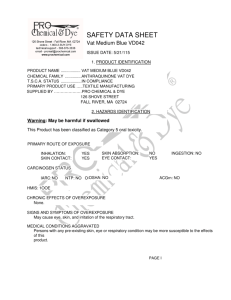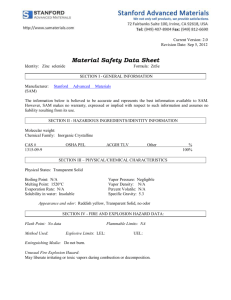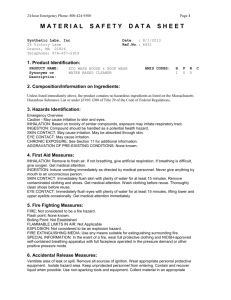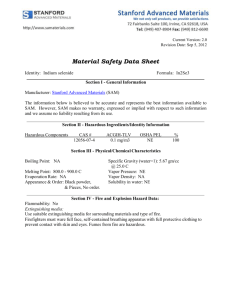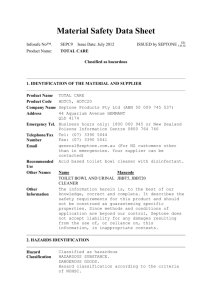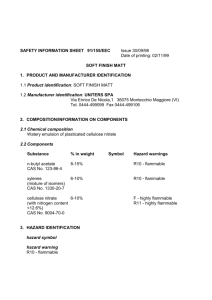Date-Issued
advertisement
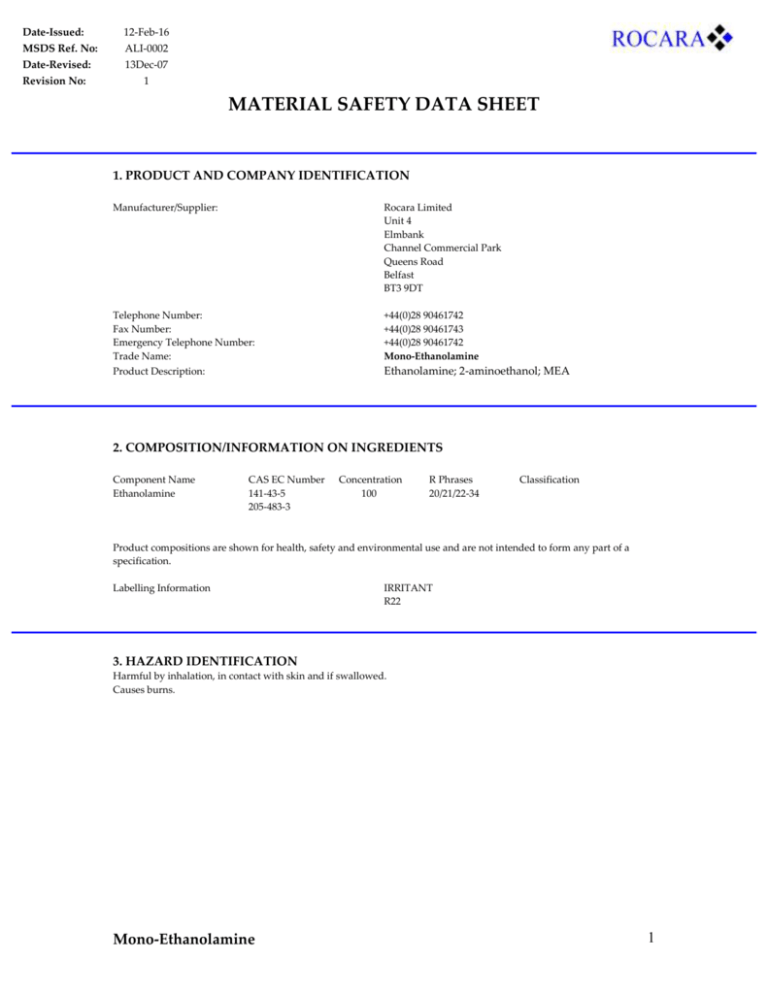
Date-Issued: 12-Feb-16 MSDS Ref. No: ALI-0002 Date-Revised: 13Dec-07 Revision No: 1 MATERIAL SAFETY DATA SHEET 1. PRODUCT AND COMPANY IDENTIFICATION Manufacturer/Supplier: Rocara Limited Unit 4 Elmbank Channel Commercial Park Queens Road Belfast BT3 9DT Telephone Number: Fax Number: Emergency Telephone Number: Trade Name: Product Description: +44(0)28 90461742 +44(0)28 90461743 +44(0)28 90461742 Mono-Ethanolamine Ethanolamine; 2-aminoethanol; MEA 2. COMPOSITION/INFORMATION ON INGREDIENTS Component Name Ethanolamine CAS EC Number 141-43-5 205-483-3 Concentration 100 R Phrases 20/21/22-34 Classification Product compositions are shown for health, safety and environmental use and are not intended to form any part of a specification. Labelling Information IRRITANT R22 3. HAZARD IDENTIFICATION Harmful by inhalation, in contact with skin and if swallowed. Causes burns. Mono-Ethanolamine 1 4. FIRST AID MEASURES First Aid – Inhalation First Aid – Ingestion First Aid – Eyes First Aid- Skin Advice to Physicians If breathing problems develop; consult a doctor/medical service. Remove the victim into fresh air. Unconscious: maintain adequate airway and respiration. If you feel unwell: consult a doctor/medical service Immediately after ingestion: give lots of water to drink Never give water to an unconscious person Do not induce vomiting. Rinse the eye with water immediately, while lifting the eyelids. Make sure to remove any contact lenses from the eyes before rinsing. Continue to rinse for at least 15 minutes.Get medical attention if any discomfort continues. Do not apply neutralizing agents. If irritation persists consult a doctor/medical service. Consult a doctor/medical service. Wash immediately with lots of water and soap for 15 minutes. Remove clothing while washing. First aid personnel must be aware of own risk during rescue. 5. FIRE FIGHTING MEASURES Extinguishing Media Unsuitable extinguishing media Special exposure hazards Instructions Special Protective equipment for firefighters Water spray. Alcohol-resistant foam. BC powder. Carbon dioxide. Container may slop over if solid jet is applied. Material presenting a fire hazard. Heat/Fire exposure: release of toxic and corrosive gases/vapours (nitrous vapours, ammonia, carbon monoxide-carbon dioxide) Cool tanks/drums with water spray/ remove them into safety. Dilute toxic gases with water spray. Take account of toxic firefighting water. Use firefighting water moderately and contain it. Corrosionproof suit. Heat/fire composure: Compressed air/oxygen apparatus. 6. ACCIDENTAL RELEASE MEASURES Methods of cleaning up Take up liquid spillinto a non combustible material e.g. dry sand/earth/vermiculite. Shovel absorbed substance in closing drums. Carefully collect the spill/leftovers. Damaged/cooled tanks must be emptied. Take collected spill to manufacturer/competent authority. Clean contaminated surface with an excess of water. Wash clothing and equipment after handling. Environmental Precautions Prevent soil and water pollution. Prevent spreading in sewers. Contain released substance, pump over in suitable containers. Plug the leak, cut off the supply. Dam up the liquid spill. Mono-Ethanolamine 2 7. HANDLING AND STORAGE Usage Precautions: Observe very strict very strict hygiene-avoid contact. Do not discharge the waste into the drain. At temperatures inferior to the melting pot: avoid raising dust. Remove contaminated clothing immediately. Clean contaminated clothing. Storage: Keep container tightly closed. Store in a cool area. Store in a dry area. Store in a dark area. Keep away from heat sources, oxidizing agents, acids, reducing agents, bases, water/moist. Storage Temperature: Quantity limits: Storage life: Materials for packaging: Suitable : Glass To avoid: aluminium, iron, copper, zinc, bronze 20 N.D. kg 2 Years 8. EXPOSURE CONTROLS/ PERSONAL PROTECTION Occupational Exposure Standards: Engineering Control Measures: The following protection is recommended: Hand Protection: Eye Protection: No occupational exposure limit listed in current editions of EH40 (UK Health and Safety Executive or Threshold Limit values (American Conference of Governmental Industrial Hygienists.) Engineering methods to prevent or control exposure are preferred. Methods include process or personnel enclosure, mechanical ventilation (dilution and local exhaust), and control of process conditions. If engineering controls and work practices are not effective in preventing or controlling exposure, then suitable personal protective equipment, which is known to perform satisfactorily, should be used. There should be local procedures for the selection, training, inspection and maintenance of this equipment. Must not be handled in confined space without sufficient ventilation. Chemical resistant gloves required for prolonged or repeated contact. The most suitable glove must be chosen in consultation with the gloves supplier, who can inform about the breakthrough time of the glove material. In risk of splashing wear safety goggles or face shield. Body Protection: helmet. Wear impermeable safety footwear and industrial safety Hygiene Measures: DO NOT SMOKE IN WORK AREA! Promptly remove any clothing that becomes contaminated. Wash at the end of each work shift And before eating, smoking and using the toilet. Mono-Ethanolamine 3 9. PHYSICAL AND CHEMICAL PROPERTIES Physical State Colour Odour pH Boiling Range/Point (°C) Solubility in Water (kg/m³) Density (kg/m³) Vapour pressure Viscosity Liquid Colourless unpleasant 25 % solution 12°C ca. 171 Complete 1.050@ 25 <0.1 mmHg @ 21 46 mPas @ 10. STABILITY AND REACTIVITY Conditions to Avoid: Materials to Avoid: Hazardous Decomposition products: Hygroscopic. Unstable on exposure to light. Keep away from heat sources, oxidizing agents, acids, metals, water/moist. Keep away from aluminium, iron, copper, zinc, bronze. Decpmposes on exposure to light. Oxidizes slowly on exposure to air. This reaction is accelerated on exposure to temperature rise and (some) metals. Absorbs the atmospheric CO2. Heat/fire exposure; release of toxic and corrosive gases/vapours (nitrous vapours, ammonia, carbon monoxide- carbon dioxide). Reacts on exposure to temperature rise with (some) metals: release of highly flammable gases/vapours: Hydrogen. 11. TOXICOLOGICAL INFORMATION Inhalation; Ingestion: Skin contact: Eye contact: Mono-Ethanolamine Not relevant at normal room temperatures. When heated harmful vapours may be formed. Harmful or fatal if swallowed. May cause nausea, vomiting or diarrhorea Prolonged contact may cause dryness of the skin. May cause defatting of the skin, but is not an irritant. May cause temporary eye irritation. 4 12. ECOLOGICAL INFORMATION Ecotoxicity Not regarded as dangerous for the environment. The product components are not classified as environmentally hazardous. However, this does not exclude the possibility that large or frequent spills can have a harmful or damaging effect on the environment. LC 50, 96 Hrs, FISH mg/l 51,400 (fathead Minnow), 51, 600 (Salmon) EC 50, 48 Hrs (Daphnia magna), 27,300 (Saltwater mysid) IC 50, 72 Hrs, Algae, mg/l 24,200 (Freshwater algae) 19,300 (Marine algae). Mobility Persistence / Degradability Bio-accumulation Water Hazard classification The product is soluble in water. BOD: 87 to92% thOD (28 day) BCF <1.5 Not expected to bioaccumulate WGK 1 13. DISPOSAL Provisions relating to waste: Waste material code (91/689/EEC, council decision 2001/118/EC, O.J. L47 of 16/2/2001): 07 01 04* (other organic solvents, washing liquids and mother liquors) KGA (the Netherlands) : category 03. Hazardous waste (91/689/EEC). Disposal Methods: Recycle by distillation. Remove to an authorized waste incinerator for solvents. Obtain the consent of pollution control authorities before discharging to waste water treatment plants. Do not discharge into surface water. Packaging: Waste material code packaging (91/689/EEC, council decision 2001/118/EC, O.J. L47 of 16/2/2001) : 15 01 10* (Packaging containing residues of or contaminated by dangerous substances). Mono-Ethanolamine 5 14. TRANSPORT INFORMATION General: Sea Transport Notes: Not classified as hazardous for transport. Marpol 73/78 IBC code chapter 18: Proper shipping namePropylene glycol 15. REGULATORY INFORMATION LABELLING INFORMATION: R phrases S phrases 20/21/22 34 (01/02) 26 36/37/39 45 UK Regulatory References The control of substances hazardous to health regulations 1988. Health and safety at work act 1974. The chemical (Hazard information and packaging for supply regulations) 1993 amended & 2002. CDG Road, The classification, packaging and labeling regulations 1996. EU Directives Dangerous substance Directive 67/548/EEC Dangerous preparations Directive 1999/45/EC. Statutory Instruments Chemicals (Hazard information and packaging) Regulations. Control of substances hazardous to health. Approved code of practice Classification and Labelling of substances and preparations Dangerous for supply Guidance notes Workplace Exposure limits EH40 16. OTHER INFORMATION Disclaimer The information contained in this document is intended to describe the product only in terms of health, safety and environmental requirements for the purposes of its safe handling, use and disposal and is to the best of ROCARA Limited’s knowledge and belief correct. ROCARA Limited Technical Services will be pleased to give further advice and assistance, but customers must satisfy themselves (by appropriate testing if necessary) that the product is suitable for their purposes and conditions of use and that their facilities and arrangements are suitable for handling or using the product. Accordingly ROCARA Limited disclaims any liability for loss, injury or damage which may result from the use of the product, this information or from such advice and assistance save as may be expressly agreed under its terms of sale. This information does not comprise a technical or performance specification for the product and customers are referred to any relevant product technical information or specification issued by ROCARA Limited. Customers are also reminded that there may be uses or application for the product which are protected by ROCARA Limited or third parties' patent rights and nothing herein may be construed as an authority or encouragement to use or apply the product in contravention of such rights. Mono-Ethanolamine 6
